By:
- Christine Clark
Published Date
By:
- Christine Clark
Share This:
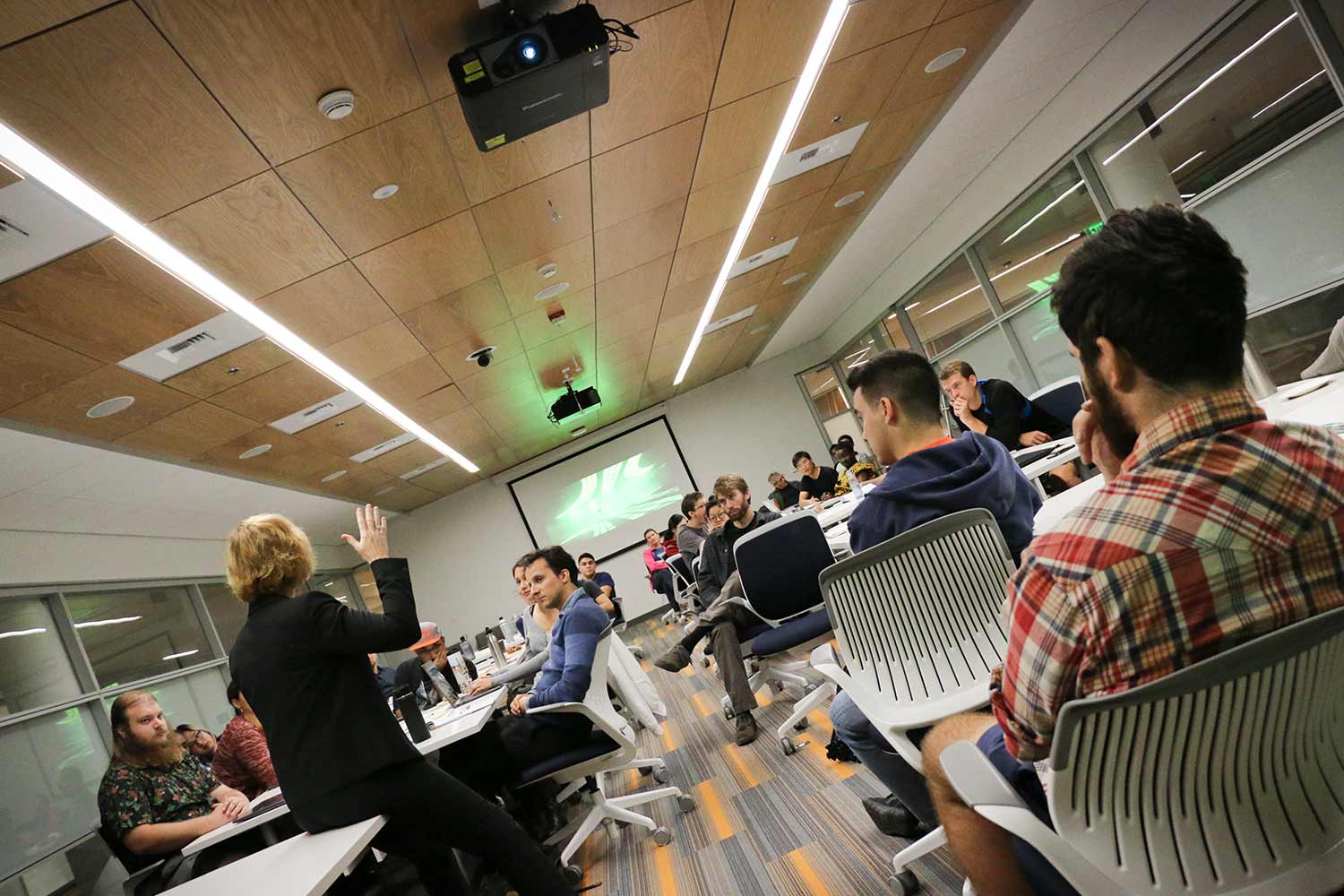
SD 2049 students work in small, interdisciplinary teams, they are tasked with looking to the San Diego border region in the year 2049 and how change may impact life here in a number of ways. Photos by Kelly Mullins/School of Global Policy and Strategy
San Diego 2049 Challenges Graduate Students to Solve Tomorrow’s Problems Today
Earlier this month, it was announced an Amazon Echo might be a key witness in a murder trial. This is not the first time a tech company—or even Amazon—has been pulled into a criminal investigation, which has ignited a heated debate about the privacy of individuals in the face of security risks. As technological advances outpace the policies needed to regulate them, UC San Diego’s School of Global Policy and Strategy, in partnership with the Arthur C. Clarke Center for Human Imagination, has launched an innovative new program arming students with the tools of science fiction in order to anticipate and highlight future policy issues.
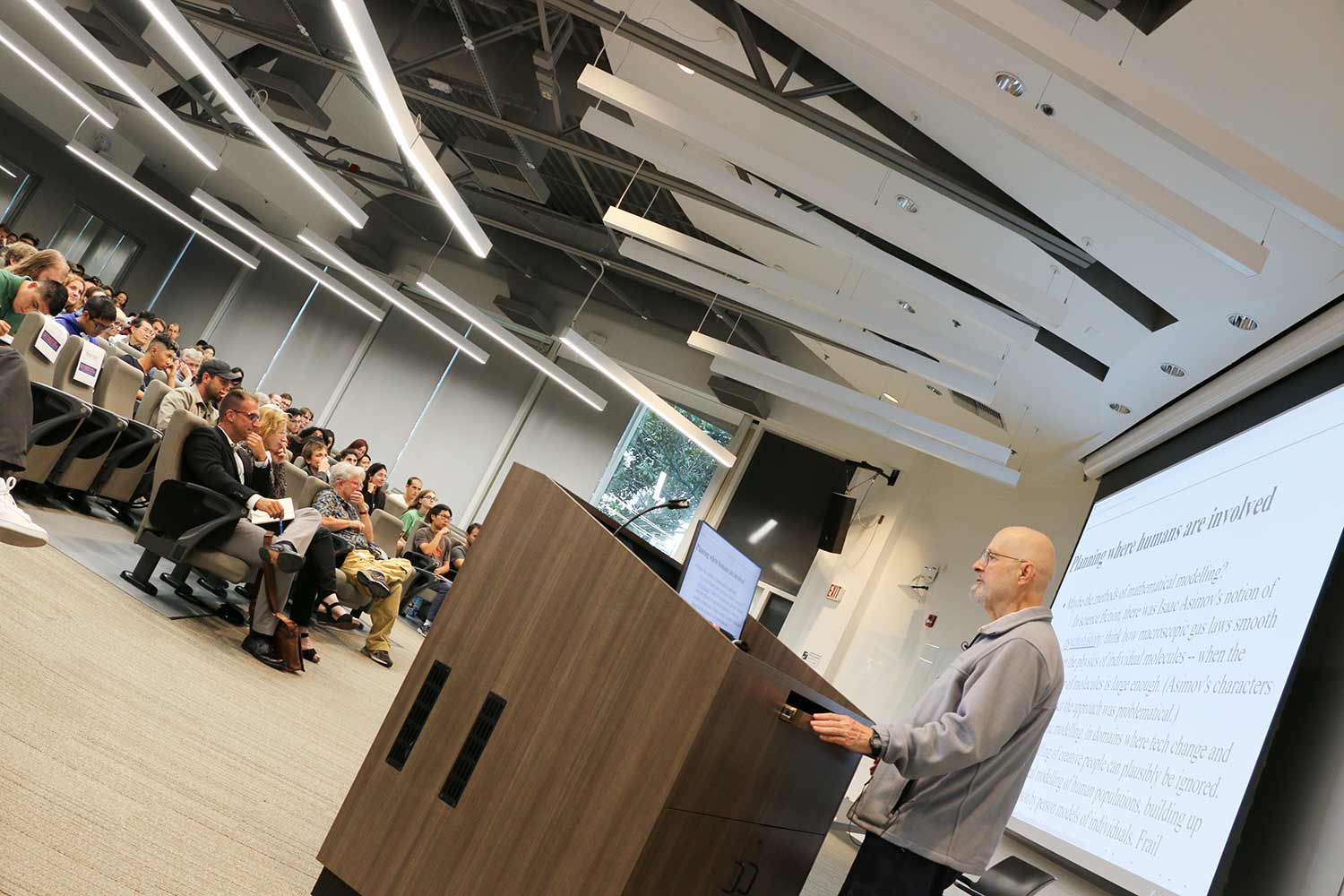
Author and alumnus Vernor Vinge.
The program, San Diego 2049, challenges UC San Diego’s graduate students to think outside the box and imagine a world unlike the one they are living in today. In small, interdisciplinary teams, they are tasked with looking to the San Diego border region in the year 2049 and how change may impact life here in a number of ways. These issues range from climate change; to the emergence of new artificial intelligences; the redrawing, or complete removal of national boundaries; low-cost gene editing and more.
“Imagining the future helps us react to unanticipated situations,” said John Ahlquist, associate professor of political science at the School of Global Policy and Strategy and program director for San Diego 2049. “We conceived this program out of the question, ‘What are we doing to more concretely train future policymakers and problem-solvers?’ We found it made sense to create a program that requires us to imagine alternate futures, if we really want our scholars to be able to shape societal change for the better.”
This yearlong program contains public talks and academic panels, a certificate in “Speculative Design for Policymaking” for students, and wraps up with a competition. Over the course of the program, students, faculty, policymakers, the public and industry experts, as well as notable science fiction writers, such as such as Annalee Newitz and Tananrive Due as well as alumni Kim Stanley Robinson and Vernor Vinge, will all share ideas and knowledge as they imagine the area’s sandy shores in 2049.
In order to earn the certificate, students form teams to design a vision for the San Diego region within the next three decades and create an intervention into that future. Throughout the program, students are taught sophisticated futurist methods to develop robust scenarios, clarify problems and develop solutions in a rapidly changing, emergent near-future. Essentially, they are worldbuilding: constructing and contextualizing an imaginary, future world.
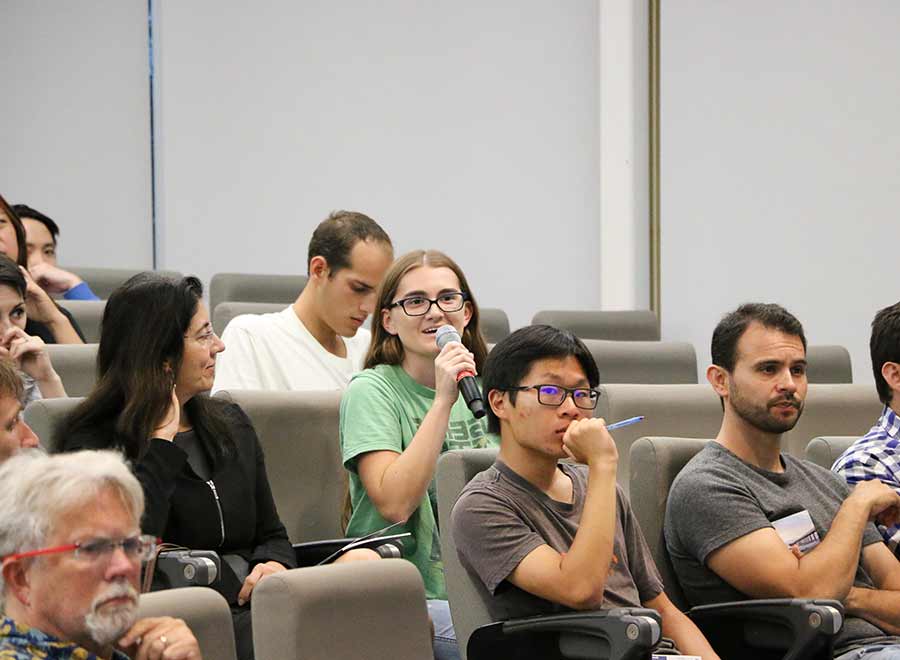
Throughout the program, students are taught sophisticated futurist methods to develop robust scenarios, clarify problems and develop solutions in a rapidly changing, emergent near-future.
Worldbuilding is a critical component to many popular science fiction films, such as “Minority Report,” “2001: A Space Odyssey” and most recently “Blade Runner 2049.” These productions were made possible by teams of futurists and experts from across disciplines who were charged with creating fictional future worlds detailed in their execution, presenting a provocative and persuasive point of view based on real-world constraints. Increasingly, worldbuilding methods are used by corporations, government agencies, nonprofits and activists to imagine alternate paths for the future, and then identify from among these possibilities the most desirable outcomes.
To prepare students for worldbuilding, each quarter the program brings in prominent guest speakers to meet with students. Participants also attend faculty panel discussions on topics expected to be of critical importance to the region in the coming decades, such as the future of labor, work and industry, robotics, bioengineering and synthetic life. For the policy implication component of the program, each student team is paired with a GPS faculty mentor for guidance.
The interdisciplinary program is open to students across divisions and was launched this fall as part of the School of Global Policy and Strategy’s 30th anniversary.
“Our school was founded on forward-thinking principles,” said GPS dean, Peter F. Cowhey. “This program underscores our commitment to preparing future generations with the tools necessary for shaping policies solutions for the world’s most complex challenges today and in the years to come. The problems we will face will require innovative, inquisitive and imaginative solutions, and by working across units on campus, students will gain the necessary perspectives and resources.”
A Legacy Steeped in Science Fiction
According to Patrick Coleman, assistant director of the Clarke Center, which is housed within the Division of Physical Sciences, the science fiction genre and speculative culture more generally benefits society by serving as a tool for us to collectively think about the future.
“Science fiction brings our attention to both problems and possibilities that we did not see were there and encourages us to think about their impact on individual people. Once we’re aware of these opportunities, we can act on them,” he said. “For example, ‘2001: A Space Odyssey’ has been a cultural touchstone about the danger of artificial intelligence for more than 50 years through its story about the threat a sentient computer poses to two fictional astronauts in a specific vision of what’s now 17 years in the past for us. But to this day, every time a new AI technology is introduced, HAL is often referenced as a way to help us understand it and its implications.”
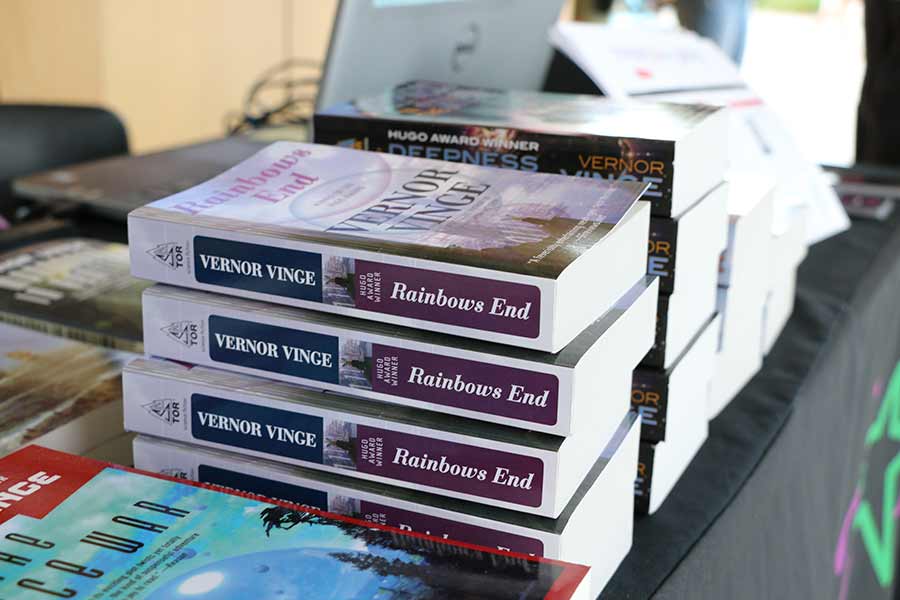
UC San Diego has spawned famous science fiction authors such as Annalee Newitz, Tananrive Due as well as alumni Kim Stanley Robinson and Vernor Vinge.
A program like San Diego 2049 is a natural fit for the campus and the surrounding area. The San Diego region is featured prominently in contemporary science fiction, most recently in “Blade Runner 2049.” The city is also home to San Diego Comic-Con.
UC San Diego is especially visible with the Clarke Center and its Clarion Science Fiction and Fantasy Writers’ Workshop, as well as the campus’s futuristic-looking Geisel Library. In addition, the campus has spawned famous science fiction authors such as Robinson, Vinge, David Brin, Catherynne Valente and others.
Many of these alumni writers are collaborators in the program. Each quarter, students have one recommended sci-fi book to read and are invited to a public talk from the author of that book. The first was Vinge, whose “Rainbows End” was the reading for fall and who spoke on campus Oct. 12. “Rainbows End” takes place, in large part, on a near-future version of the UC San Diego campus. In addition, Robinson is serving as a judge in the competition, which will culminate in the spring when final projects are due.
The excitement around the program has been brewing among participating students and all three public events over fall quarter sold out.
Coleman credits the success of the program to many factors including the popularity of the sci-fi genre.
“We don’t have a lot of ways in which we, as a species, try to imagine the future together,” he said. “This can explain why science fiction has become an important cornerstone of culture. The world is changing so fast, and these stories—in books, films and video games—give us a common language, the way myths do, but in a very contemporary way.”
Shaping the problem-solvers of tomorrow
Students like Joseph Owuondo, who is earning a masters in public policy degree at the School of Global Policy and Strategy has signed up to do innovative work around cybersecurity.
“I didn’t come to school to get a piece of paper, I came to school to innovate and design solutions,” Owuondo said, who immigrated to the U.S. from Kenya six years ago. He is an Afghanistan war Marine Corps veteran. “Because of my background in security, this program presented the perfect opportunity to contribute to national security…The next war is not going to be with guns and bombs, it will be an informational warfare.”
Owuondo’s project is in its infancy stages but he knows he wants to identify, reduce and mitigate vulnerabilities of San Diego’s critical infrastructures and key resources such as power grids, water systems, transportation systems, emergency services, communication, etc. He sees the need for a proactive cybersecurity public-private partnership in these sectors. He believes such partnership is vital in connecting policy, technology and academia.
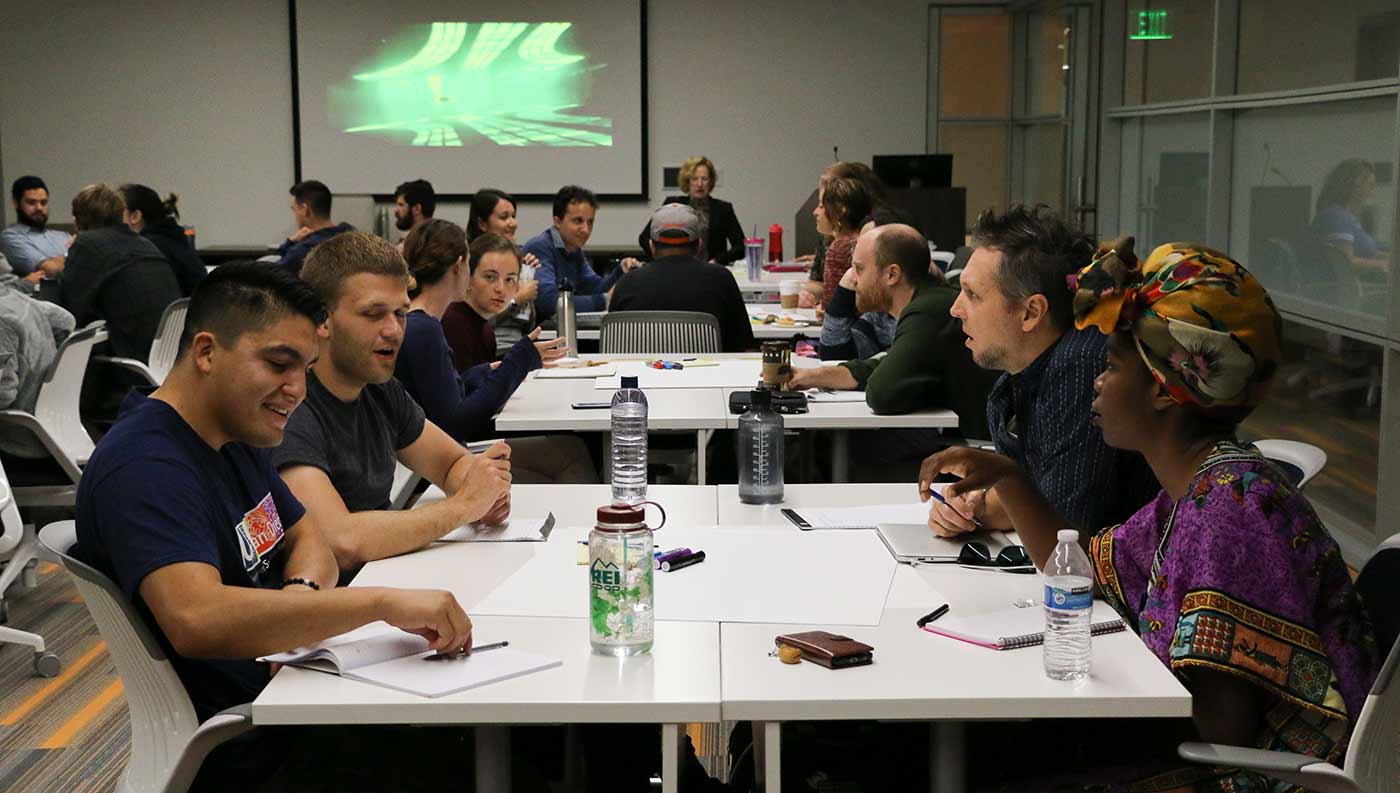
One of the strengths of the programs is that it is truly interdisciplinary with students across division working together.
In addition to the School of Global Policy and Strategy, graduate students from the Jacobs School of Engineering, Scripps Institution of Oceanography, School of Medicine, and departments of Visual Arts, Communications, Ethnic Studies, Music and more are participating in the program.
“We have seen a real hunger from students to do this interdisciplinary work,” said Wendy Hunter Barker, assistant dean at GPS, who helped launch the program as part of the school’s 30th anniversary. “GPS is well-suited to lead this type of effort with our school’s ethos of breaking the status quo to examine problems from all sides. This is why our faculty come from a range of disciplines in the social sciences, physical sciences, neurosciences, engineering and more.”
One of the strengths of the programs is that it is truly interdisciplinary, according to Coleman.
“Breaking interdisciplinary boundaries is hard to do,” he said. “But worldbuilding is not possible without it.”
The final projects due in spring can take whichever medium the team deems best to convey its intervention into the future. Some teams may choose to write a policy paper about this prospective world; others may want to create a film following a character or create a podcast of a news program set in the year 2049.
Teams will compete for highly coveted prizes, which will be announced in winter quarter. The next public San Diego 2049 event will take place in January, in which the program will host a talk by alumna Rose Eveleth, host of the podcast “Flash Forward,” which tackles a possible (or not so possible) future scenario each week.
For more information about San Diego 2049, go to the Flash Forward website.
Share This:
You May Also Like
Stay in the Know
Keep up with all the latest from UC San Diego. Subscribe to the newsletter today.



